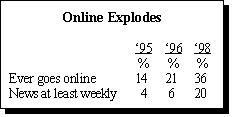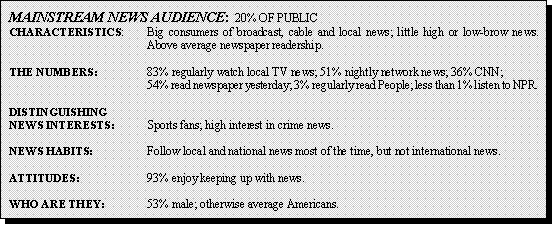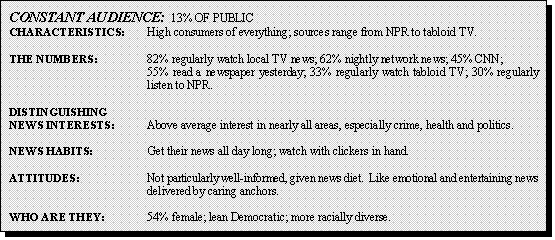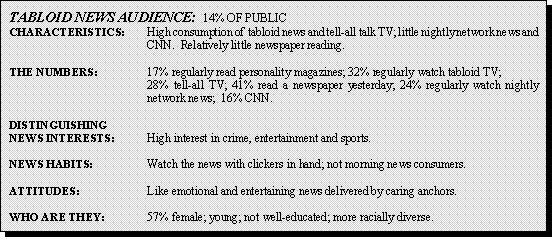Introduction and Summary
The Pew Research Center’s biennial news use survey finds that overall Americans are reading, watching and listening to the news just as often as they were two years ago. But the type of news Americans follow and the way they follow it are being fundamentally reshaped by technological change and the post-Cold War news climate.
The number of Americans obtaining news on the Internet is growing at an astonishing rate, and watching varied cable news outlets is now just as common as viewing network news programming. Reflecting these profound changes, the percentage of Americans who watch only nightly network and local television news has fallen to 15% from 30% in 1993. The fickle mood of today’s news consumer is further illustrated by the fact that over half of Americans watch the news with a remote control in hand.
As the public’s appetite for national and international news wanes, viewership of nightly network news continues its decline. And viewership of CNN, the principal cable news source, remains in its mid-1990s slump. Strong interest in news closer to home is sustaining audiences for local television news and daily newspapers. The audiences for print and TV news magazines also have held steady since 1996, as has the tabloid television audience.

The Center’s polling documents the media’s difficulty in attracting young people to the news. It illustrates how differently the generations are responding to the information explosion. Only 33% of Americans ages 18-29 say they enjoy keeping up with the news a lot, but 77% say they like having so many information sources. In contrast, 68% of seniors like following the news, but only 52% like all the television news shows, magazines and computer information services at their disposal today.
The Pew Research Center’s survey of 3,002 adults conducted by phone April 24-May 11, 1998, identifies six groups of news consumers whose varied news choices, habits and values reveal the diversity — if not fragmentation — of today’s news audiences. The demographic, cultural and behavioral differences among these groups challenge the news media’s ability to draw and maintain a mass audience.
A separate survey of 981 adults conducted by phone May 7-13, 1998, found that despite intense public criticism of media coverage of the alleged White House sex scandal, credibility ratings for individual news organizations and personalities did not slip further this year. And, the popularity of the tabloid programs and publications notwithstanding, the public continues to make clear distinctions between them and the mainstream press. The Wall Street Journal and CNN achieved the highest believability ratings; the National Enquirer and Inside Edition by far the lowest of the 20 outlets tested.
Following is a summary of the principal findings of the two surveys and a description of a news audience typology. A discussion of online news use can be found in Section 1, on page 8. An overview of what Americans are watching, reading and listening to is featured in Section 2, beginning on page 11. Generational patterns of news consumption, along with information about how and when Americans get their news, are discussed in Section 3, American News Habits, beginning on page 18. News media credibility is discussed in Section 4, beginning on page 22. And finally, other public attitudes toward the media are covered in Section 5, beginning on page 25.
Principal Findings

The percentage of Americans getting news from the Internet at least once a week more than tripled in the past two years — going from 11 to 36 million news users. For those who go online, science, health, finance and technology are big news draws.
The survey finds no evidence that going online for news leads to less reading or viewing of more traditional news sources. People who go online for news say that their news habits are unchanged. Analysis of the polling confirms this in finding that their news consumption patterns do not differ significantly from non-users, all other things being equal.
But It’s Cable Now

Despite dramatic growth in online news consumption, cable television’s impact remains far greater. Fully 40% of Americans now regularly watch one of the cable news networks, compared to 57% who regularly view network news broadcasts including morning, evening and magazine shows.1 The size of the gross cable news audience swells to 60%, however, when specialty programming such as the Weather Channel and ESPN’s Sports Center are factored in.
Cable’s advantage lies in its immediacy. Americans say they would turn to cable channels first in the event of a big news story, whether it concerned politics, health or sports.2
And in an era of expanded choices and economic prosperity, big news is what is required to attract big audiences. A substantial minority of Americans (46%) only follow national news when something major is happening and an even greater number (63%) react the same way to international news. Only local news attracts a large regular audience that is not event driven — 61% of Americans follow it most of the time.
Softer News Values
While accuracy and timeliness are the news values most important to consumers, a large segment of the news audience wants entertaining and enjoyable news presented by personalities who deliver it in a caring way. Americans who value caring anchors and news that stirs emotions are among the most regular viewers of local news and television magazine shows. Viewers of tabloid television also place a higher premium on news that stirs emotions. And tellingly, a significant percentage of tabloid audiences say they don’t believe the very shows they watch.
A News Typology
News consumers are highly diverse in beliefs and behaviors. The Pew Research Center survey identifies six audience groups that differ materially in their news use, interests and attitudes.3 Yet there is no dominant audience bloc among these about equally sized groups.
Today’s Mainstream News audience (20%) has middle-of-the-road preferences. They are newspaper readers and regular cable news viewers who also watch local news and network programming regularly. The Basically Broadcast audience (17%) relies primarily on local TV news, network news shows and newspapers, passing on cable news sources.


The Very Occasional audience (18%) only follows the news when something major is happening. At the other extreme is the Constant audience (13%), that watches, reads and listens to just about everything — seemingly indiscriminately. This audience group watches Hard Copy or Inside Edition and listens to National Public Radio (NPR) in about equal numbers.


In contrast, the Serious News audience (12%) is more selective. They are relatively heavy users of NPR, The NewsHour with Jim Lehrer, The Wall Street Journal, The New York Times and high-brow news and business magazines, but they are relatively light users of local and network evening news. Finally, the Tabloid audience (14%) also rejects broadcast news and favors the National Enquirer, tabloid TV and the tell-all talk shows over The New Yorker or The Atlantic Monthly.


There are few common links between these audience groups. Ironically, the daily newspaper, the oldest format, is the only news source used regularly by a majority of all groups. Local television news generates the largest audiences in many, but not all of the groups. Other news formats and programs are popular in only a few of the groups.
There is even more variation by news topic. Although local, health and crime news are followed by nearly all audiences, political news from Washington is only followed very closely by significant percentages of the Serious News and Constant audiences. International and cultural news attract the Serious News audience in more substantial numbers than average.
Wide variations in attitudes toward the news are also apparent. The Serious News audience is less enthusiastic about enjoyable and entertaining news. The Constant and Tabloid audiences are most likely to value anchors who deliver the news in a caring way.
The diversity among these groups helps explain why news outlets rely heavily on blockbuster stories to achieve larger audiences. Alternatively, some news organizations pursue the specialized interests of niche audiences, which technology is making ever more possible.




